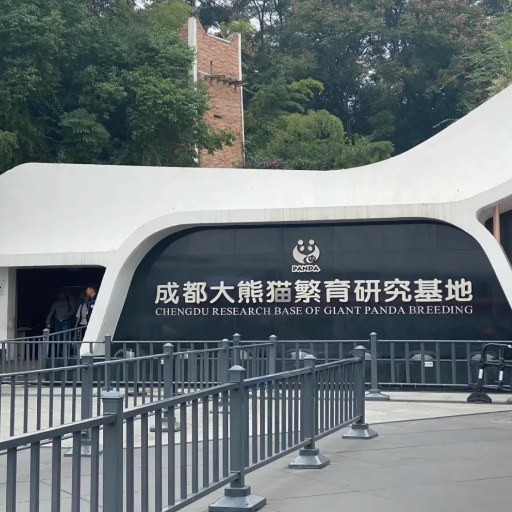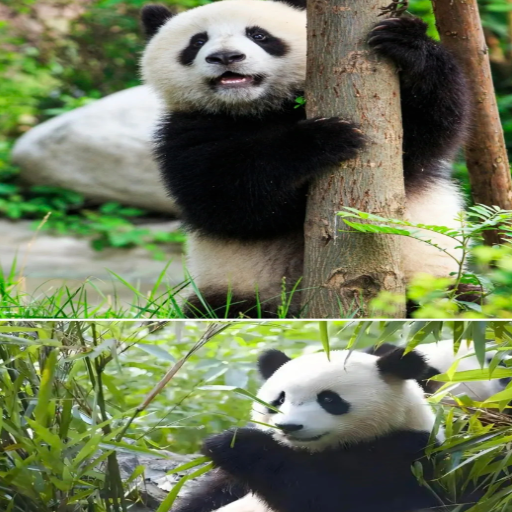Look at this detailed guide on Chengdu Panda Tour 2025; with this article, you have everything you need to travel to the Giant Panda Base in Chengdu, China. This guide outlines everything from ticket fees and operational hours to the on-ground activities and attractions you can participate in. This guide is geared towards making your trip enjoyable and unforgettable. This guide also contains tips for when the best times for visiting are, as well as looking into pandas’ conservation efforts and other places of interest to enrich your experience in Chengdu. Whether it’s the wildlife, the charming sass of the pandas, or simply the sheer joy of it all, this guide has got you and so much more.
What is the Chengdu Research Base of Giant Panda Breeding?

What is the Chengdu Research Base of Giant Panda Breeding
The Chengdu Research Base of Giant Panda Breeding is a world-renowned conservation facility dedicated to breeding, researching, and preserving giant pandas. Situated in Chengdu, China, this center was inaugurated in 1987 to save endangered species and their natural environment. It combines scientific research with public education, allowing the public to view pandas of different life stages naturally while learning about their survival techniques.
History and Purpose of the Giant Panda Base
The Giant Panda Base was established in 1987 with an initial population of six captive-bred pandas. Its primary aim is to save and replenish the giant panda population through sophisticated captive-breeding strategies, habitat protection, and scientific research. The base has developed a stable and sustainable environment through integrated genetics research, extensive breeding, and disease control efforts. Over time, it has grown into one of the leading institutions for preserving pandas and currently houses over two hundred pandas, according to the latest estimations.
Specialized insemination procedures were developed to achieve technology milestones and enhance breeding success rates. These procedures also focus on habitat simulation, controlling temperature, humidity, and vegetation to provide pandas with the closest environment to their natural setting. Conservation programs encompass the reintroduction phase, where pandas born in captivity are gradually placed in protected areas to survive and adapt to nature.
Facilities and attractions at the Chengdu Panda Base
The Chengdu Panda Base is famous for its state-of-the-art facilities, which educate and enhance visitors’ experiences while promoting conservation. The base includes several multi-purpose enclosures for the care of pandas. These include the Giant Panda Nursery, which has climate-controlled facilities and automated feeding equipment for newborn cubs. Observation windows allow the public to see baby pandas and learn about their early development stages.
Another highlight of the base is the viewing area for the cubs, the Giant Panda Enclosure. This area contains bamboo trees, climbing structures, and open regions simulating their natural environment. Well-designed habitats at the base also allow viewing of red pandas in the Red Panda Exhibit. In addition to the red panda exhibit, the base includes an educational museum dedicated to panda biology, conservation, and history, which they present interactively.
The Panda Kitchen is a unique behind-the-scenes section that shows guests the pandas’ diet and how their bamboo and protein biscuits meals are intricately prepared. Furthermore, the base provides lovely walking paths bordered by bamboo forests and greenery where guests can admire nature while looking for active pandas.
If you wish to participate more, the Panda Keeper Program allows deeper engagement by helping staff feed and care for the pandas with expert supervision. This program is popular among wildlife lovers as it combines lectures on panda biology and conservation.
How do you plan your visit to the Chengdu Panda Base in 2025?

How do you plan your visit to the Chengdu Panda Base in 2025
Different steps should be followed to ensure a smooth and pleasant experience for the Chengdu Panda Base. First, check the official site for updates about the opening hours, ticket prices, or seasonal activities/restrictions. It is strongly recommended that you purchase tickets beforehand so that you do not have to wait in long lines or run the risk of the ticket selling out. Try to visit early in the morning, when the pandas are the most active and feeding. Wear loose-fitting clothing, walking shoes, and any other comfortable shoes, as the base requires outdoor walking. Another thing to consider is getting a guided tour or an audio guide, which will provide invaluable information. Lastly, follow any travel restrictions in the area and figure out how you’ll get to the base, a little over 10 kilometers from Chengdu’s city center.
Best time to visit and see pandas
Seeing pandas is best from the start of winter through early spring (November – March). The pleasant weather can also improve the pandas’ activity levels and the visitors’ experience. For the best experience, visit between 8 and 10 in the morning. The pandas are most active at that time, feeding, playing, or climbing. If you plan on visiting during a holiday or peak, arriving early will ensure you avoid large crowds. Following these tips will guarantee an enjoyable experience watching these magnificent creatures.
Ticket prices and tour packages
You can see the adorable panda bears here. Tickets for most panda centers range from $10 to $20 for adults. Children’s tickets are often priced at a reduced rate, usually around 50 percent of the standard adult fee. Some centers offer free entry for children below a certain height, commonly set at 1.2m or 3.9ft.
Tour packages are different for each type and experience. For example, guided tours that include detailed information about panda bears cost $30 to $50 per person, while special behind-the-scenes tours where listeners can actively participate in panda care, such as feeding them, start at approximately $80.
Details:
- General Entry Tickets: $10-USD 20 (per adult).
- Children’s Tickets: 50% off or free below 1.2 meters (3.9 feet).
- Guided Tours: USD 30 50 (per person).
- Extraordinary Experiences: Starting from USD 80 (per person).
Booking tickets and packages beforehand, especially during rush or peak season, is advisable to feel secure about your available slots and options.
Transportation options to the Panda Base
Different options can fit different preferences and budgets, allowing easy access to the Panda Base. I opt for the Didi ride-hailing service or taxi, which costs anywhere from $10-USD 20, depending on your starting point and traffic. If you’re feeling a little more adventurous, you can try the public buses, which, for a dollar or less, will take you by Bus No. 198 or Bus 87, which are both overground services near the base. However, remember that this route can take a long time due to the many bus stops, but the price is fantastic. If you’d rather drive yourself, that’s an option, too, as parking is allowed on-site and typically costs around $2-USD 5 per day. Each choice includes accessibility and flexibility, so plan based on your time and budget.
What can you expect to see during your Chengdu Panda Tour?

What can you expect to see during your Chengdu Panda Tour
On your Chengdu Panda Tour, prepare to see giant pandas up close in their panda habitats. Generally, tourists watch pandas eat bamboo, play, and relax in the enclosures designed to replicate their habitat. The tour might include red pandas, observing panda caretaker routines, and other educational presentations about panda conservation. This tour allows visitors to understand and appreciate the efforts made by these cute animals and the need to protect them.
Giant pandas and their enclosures
To give the giant pandas the best care possible, their enclosures are built to look like their natural environment. These enclosures include bamboo forests serving food and shelter, climbing structures, shaded areas, and water pools. Each panda typically needs an area of 600-1000 square meters, depending on how many other pandas share the enclosure.
The temperature is necessary for pandas because they are used to living in mountainous regions. Enclosures are kept at 15 to 25 degrees Celsius, while humidity levels are between 50 and 70 percent. There is also a special feeding area where caretakers can observe the pandas as they eat fresh bamboo, fruits, and vegetables, along with specially designed panda cakes.
These design features allow the animal to remain concealed, promoting panda observation and conservation. They also ensure the panda’s wildlife health is monitored and their breeding and conservation are sustained.
Red pandas and other wildlife
Distinct from the giant panda, the red is another species of small tree-climbing mammal found in the Himalayan region and the adjacent countries. With their reddish brown fur and a bushy, ringed tail, red pandas primarily eat bamboo, together with fruits, berries, insects, and other smaller vertebrate animals. They are known for their role as seed dispersers, which benefits their forest ecosystem. They are primarily on their own and are more active at or around twilight, which is called crepuscular activity.
The IUCN has labeled red pandas endangered, and their populations barely reach 10,000. Habitat destruction, poaching, and climate change are some of the significant threats to their population. Their conservation is aided by community participation, protected zones, and reforestation efforts.
The habitats are also home to the Himalayan monal, various birds, snow leopards, and the Himalayan black bear. Each species has its own unique set of adaptations. For example, the snow leopard is covered in thick fur and has a fat reserve, allowing them to survive in extreme alpine environments. Simultaneously, the monal blends into forested areas very well. Recognizing that many species depend on the exact location, conservation programs aim to protect entire ecosystems. Developing technologies like GPS Tracking and camera traps allow researchers to monitor these animals and devise appropriate conservation strategies.
Panda nursery and baby pandas
Panda nurseries serve an essential function in saving the giant panda from extinction. The Panda nurseries are controlled and specialized facilities that care for baby panda cubs for the first 3 years, during which they are fed, medically cared for, and monitored. Newborn pandas are especially at risk immediately after birth, weighing 90 to 130 grams, almost 1/900th of their mother’s weight. For the first few months, baby pandas consume their mother’s milk before being able to switch to bamboo.
An approachable panda nursery is managed by experts who ensure the temperature is maintained at 20-25 degrees centigrade, which is also the ideal humidity range of 50-70%. Such conditions are necessary to mimic the pandas’ native surroundings. The cubs’ health metrics (weight, body temperature, and feeding schedules) are also tracked using advanced monitoring systems. All these measures help support panda cubs during their most vulnerable phase and aid long-term conservation efforts.
Are there exceptional experiences available at the Chengdu Panda Base?

Are there exceptional experiences available at the Chengdu Panda Base
Indeed, the Chengdu Panda Base has a range of unique visitor activities. Visitors can take part in guided tours that provide detailed information on pandas’ conservation, behavior, and habitat. Also, some patients are close to the visitors when the staff are feeding them and in their enclosures. Some programs may allow caregivers to teach the visitors basic concepts about care and research, which is very special.
Panda volunteer programs and keeper experiences
The Chengdu Panda Base has developed unique volunteer programs and keeper experiences for the most enthusiastic followers of the panda conservation movement. They may help in kitchen activities such as food preparation, enclosure cleaning, and behavior observation with the supervision of the staff. Most of these full-day programs require reasonable health and age over 12. Requirements for participation may include passing a medical examination, wearing some form of protective clothing such as gloves and masks, and other safety measures. These programs give these visitors an understanding of how to address the animal’s needs and conservation together with their care.
Photography opportunities and guidelines
Visitors can take photos to relive their panda memories with the animals. Still, some restrictions must be observed to protect the pandas and ensure their comfort. The use of flash photography is forbidden as it may disturb the animals. In addition, people must keep a distance from the pandas’ living space and are usually prohibited from being in the habitats when images are being captured. Any pictorial paraphernalia a visitor intends to use should be compact, portable, noiseless, and non-stressful so that the pandas are not agitated. These include not using flash cameras, a minimum distance of 10 feet from the pandas, and images with personal cameras that can only be used personally unless special permission is granted for them for professional purposes. All these rules protect the pandas’ comfort while allowing tourists to document their fantastic visit.
What other panda attractions are near Chengdu?

What other panda attractions are near Chengdu
Today, trip planners can get pseudoscientific with gems like the Dujiangyan Panda Base. It used to serve as a fancy resting stop for senior pandas, but nowadays, it specializes in healthcare, offering volunteer opportunities for take-a-panda-to-work-day. Also, drop by the gorgeous Ya’an Bifengxia Panda Base, which is best known for its breathtaking scenery and successful breeding programs. “Hometown of Pandas” is a reserve with its own set of cinnamon-colored bears, and thanks to the Wolong National Nature Reserve, it is simple to support panda conservation. Each location offers unique opportunities to learn about pandas while supporting their conservation.
Dujiangyan Panda Base and its unique features
The Dujiangyan Panda Base is a leading panda conservation and rehabilitation center that treats retired and injured pandas. It is about 55 kilometers from Chengdu and boasts volunteer programs that engage participants by letting them feed and clean the paddocks where pandas are kept. The facility covers an area of 51 hectares, incorporating the natural environment as part of the panda habitat to improve the pandas’ physical and mental well-being. This base is primarily concerned with rehabilitative care of senior pandas and incorporates constant health monitoring through specialized diets and checkups. Its strong educational focus and hands-on approach make the base a favorite for conservationists.
Wolong Panda Center and its conservation efforts
Wolong Panda Center in Sichuan, China, is a crucial panda conservation area in the Wolong National Nature Reserve. The reserve, which is 200,000 hectares of protected land founded in 1963, holds an estimated 150 wild pandas, almost 10% of the population. The center assists in preserving the species by conducting research, breeding, and reintroduction programs.
One of the Wolong Panda Center’s main goals is to reproduce Pandas, for which they have implanted techniques like artificial insemination. Their success rate has gone above 90% in the last few years, and breakthroughs increasing the fertility of pandas and the survival rates of cubs have dramatically aided the program. Cubs born in the center undergo “wild training, “which prepares them to survive in the wilderness before release.
The reserve has also incorporated advanced monitoring tools to supervise the movements and health of pandas in the wild and captivity. These tools include sensors and GPS collars, which allow efficient management and safeguarding of pandas’ habitats from destruction and climate change. In addition, other conservation centers send their research and methods for the center’s use, which broadens the importance of the Wolong Panda Center and makes it a world leader in panda conservation.
Outreach and education are other essential forms of conservation besides research. The Wolong Panda Center provides workshops and volunteering opportunities that allow students and researchers to contribute actively to panda conservation efforts. This aims to encourage people globally to ensure the future of the giant panda as a symbol of biodiversity and conservation.
Bifengxia Giant Panda Base and its breeding program
Here at the Bifengxia Giant Panda Base, our primary goal involves supporting the health and improving the success rates of giant panda breeding using modern techniques and precise management. Our program aims to achieve genetic diversity, incorporating advanced reproductive technologies like artificial insemination and carefully controlled mating designs. Thanks to their environment being rigidly controlled to match the pandas’ natural habitat, the facility has achieved numerous milestones, including the most significant number of cubs born in a given year.
In addition to these factors, the giant pandas are routinely provided with spacious living quarters, a nutrient-dense diet of bamboo, and constant medical attention. Breeding success is further aided by using stress and hormonal cycle tracking via low to no-contact methods. For panda comfort, it is equally important to maintain a temperature range of 64 and 75 degrees Fahrenheit (18 and 24 degrees Celsius) alongside a steady humidity level of about 50 and 70 percent. By publicly announcing and sharing this information with the world, we can further improve the global standard for panda conservation.
How do you combine your Chengdu Panda Tour with other attractions?

How do you combine your Chengdu Panda Tour with other attractions
Chengdu provides many activities to complement your panda excursion for a holistic experience. After panda viewing, you can begin the tour with the Chengdu Research Base of Giant Panda Breeding and then go to the Wenshu Monastery or Kuanzhai Alley, both incredible slices of Chengdu’s history and culture. Nature lovers can hike Mount Qingcheng, which has stunning views, while the lack of food options is undoubtedly limited in Sichuan with its mouth-watering cuisines serving on Chengdu’s Chunxi Road. Efficient and affordable public transportation, as well as private guided tours, make it possible to incorporate everything in one single day.
Day tours to Leshan Giant Buddha
The day tour to Leshan Giant Buddha is an excellent option combined with the Chengdu itinerary. It is a 100-mile drive from Chengdu to Leshan, where the most remarkable sculpture in Sichuan, the Leshan Giant Buddha, stands alone. This marvel is the world’s largest stone Buddha statue, with an astounding height of 71 meters (233 feet), and a UNESCO World Heritage Site carved during the Tang Dynasty. This monument is in the middle of the Minjiang, Dadu, and Qingyi rivers.
The travel options from Chengdu are simple since bullet trains are around one hour and buses take 2-2 hours. While in Leshan, travelers can either walk along the pathways to the Buddha for an intimate viewing or take a boat cruise, from which they can see the Buddha in all his splendor from the rivers. The price for tickets to the scenic area of the Buddha is close to 80 CNY, and boat tickets are around 70-100 CNY per person. Aside from those, the Mahao Grottoes and Lingyun Monastery attract many visitors and are located relatively close, so do not forget to visit these sights. With its stunning scenery and fascinating history, the Leshan Giant Buddha is a must-see for history lovers and cultural travelers.
Exploring Sichuan cuisine and culture
Sichuan cooking is famous for its rich use of garlic, ginger, and Sichuan peppercorns, which have a signature numbing and spicy taste called ‘ma la.’ Broadly known regional dishes include Mapo Tofu, Kung Pao Chicken, and Sichuan Hot Pot, each offering a range of mouth-watering textures and tastes. Besides gastronomy, Hamburg and China have diversified regional cultures and customs, highlighted by the mesmerizing “face-changing” Sichuan Opera and tea drinking practiced in local tea houses. If you plan to visit Sichuan, be sure to experience these highlights to understand the depth of the region. When tasting Sichuan cuisine, it is recommended to use authentic ingredients like Pixian bean paste and good quality Sichuan peppercorns. Balance the broth with complex spices and aromatic chili for a hot pot.
References
Frequently Asked Questions (FAQ)
Q: What is the best time to visit Chengdu for a China panda tour?
A: The best time for a China panda tour to Chengdu is typically from March to November. The weather is mild during these months, and pandas are more active. Spring (March to May) and autumn (September to November) offer the most comfortable temperatures and fewer crowds, making it ideal for panda viewing at the Chengdu Giant Panda Breeding Center.
Q: How can I see giant pandas during my visit to Chengdu?
A: To see giant pandas in Chengdu, you can visit the Chengdu Research Base of Giant Panda Breeding, also known as the Chengdu Panda Base. This renowned panda research facility is located about 10 km from downtown Chengdu and allows visitors to observe pandas in a naturalistic setting. You can also consider visiting other panda bases in Sichuan, such as the Dujiangyan Panda Base or the Wolong Panda Base, for different panda experiences.
Q: What does a typical day at the Chengdu Giant Panda Breeding Center include?
A: A day at the Chengdu Giant Panda Breeding Center typically includes: 1. Early morning arrival to see pandas at their most active 2. Observing adult pandas in their enclosures 3. Visiting the nursery to see baby pandas 4. Learning about panda research and conservation efforts 5. Watching educational videos about giant panda breeding 6, exploring the beautiful grounds and bamboo forests 7. Optional panda photo opportunities (additional fee may apply). Remember that the tour itinerary may vary depending on the specific package you choose.
Q: Are any exceptional panda experiences available at the Chengdu panda research base?
A: Yes, the Chengdu Giant Panda Breeding Research Base offers extraordinary experiences for visitors. These may include: 1. Volunteer programs where you can assist keepers in caring for pandas 2. Panda keeper programs for a behind-the-scenes look at panda care 3. Educational talks and workshops about panda conservation 4. Exclusive photography sessions with pandas (subject to availability and additional fees). These experiences provide unique opportunities to get closer to the pandas and learn about panda research and conservation efforts.
Q: How do I get to the Panda Base from Chengdu?
A: There are several ways to get to the Panda Base from Chengdu: 1. Public Bus: Take bus 87 from downtown Chengdu to the Panda Base stop. 2. Metro: Take Line 3 to Panda Avenue station, then transfer to a shuttle bus. 3. Taxi: It’s a 30-minute ride from central Chengdu. 4. Private Tour: Many Chinese tour operators offer panda tour packages with transportation included. The distance from Chengdu city center to the panda base is approximately 10 km.
Q: What are some other popular panda-related attractions around Chengdu?
A: Besides the Chengdu Giant Panda Breeding Center, there are several other panda-related attractions around Chengdu: 1. Dujiangyan Panda Base: Offers a panda keeper program 2. Wolong Panda Base: Known for its wild panda habitat 3. Bifengxia Panda Base: Features a panda kindergarten 4. Chengdu Zoo: Has a panda exhibit 5. Giant Panda Museum: Provides educational exhibits about panda history and conservation. These places offer diverse experiences for panda enthusiasts and are popular stops on many Chinese panda tours.
Q: What should I bring for my visit to the Chengdu Giant Panda Breeding Center?
A: When visiting the Chengdu Giant Panda Breeding Center, it’s recommended to bring: 1. Comfortable walking shoes 2. Weather-appropriate clothing (layers are best) 3. Sunscreen and a hat 4. Insect repellent 5. Water and snacks 6. Camera with a zoom lens for panda photos 7. Cash for souvenirs or additional experiences 8. Your passport (required for certain activities) Remember to respect the panda reserve rules and guidelines during your visit.